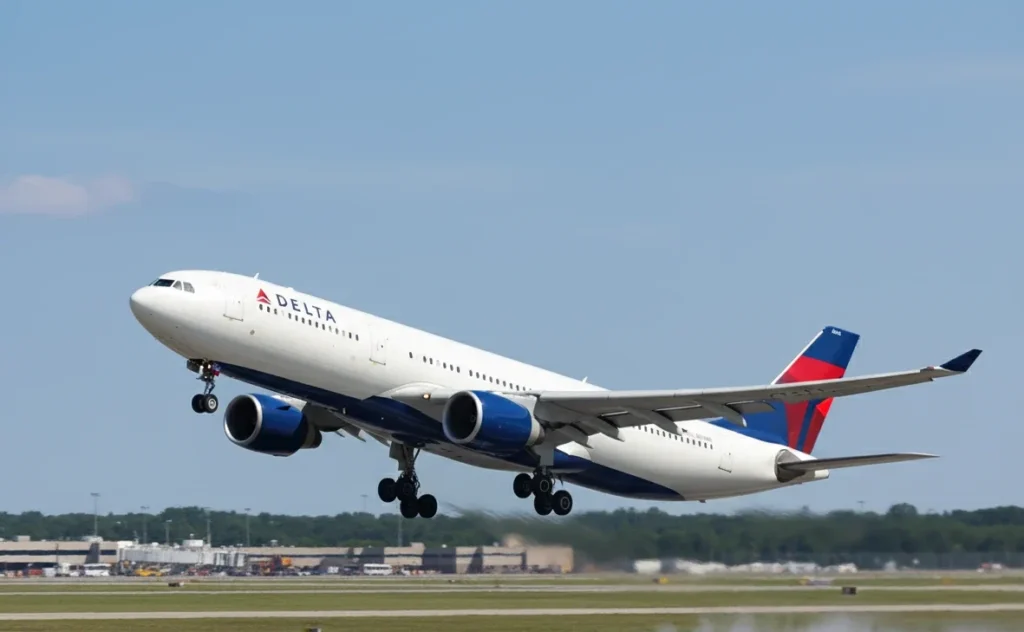The diversion disrupted travel plans for more than 300 passengers. Many had connecting flights, meetings, or family commitments in Tokyo that were delayed by one to two days.
Delta provided hotel accommodations, meal vouchers, and rebooking assistance in Los Angeles. While the diversion caused frustration, most passengers praised the professionalism of the flight crew, who kept travelers informed throughout the incident.
Delta Flight DL275 from Detroit to Tokyo diverted to Los Angeles on May 28, 2025, after a suspected problem in its engine anti-ice system. The Airbus A350 landed safely at LAX after more than 12 hours in the air, with no injuries reported among passengers or crew.
What Happened on Delta Flight DL275?
The flight took off from Detroit Metropolitan Airport on May 27, 2025, and was bound for Tokyo Haneda. About five hours into the journey, while flying over the Pacific Ocean at 38,000 feet, the pilots detected a fault in the Rolls-Royce Trent XWB engine’s anti-ice system.
This system prevents dangerous ice buildup inside the engine during cold, high-altitude flights. A malfunction could create serious risks if the aircraft continued over remote oceanic routes with limited emergency landing options.
To prioritize safety, the pilots decided to divert to Los Angeles International Airport (LAX). The Airbus A350 touched down at 01:38 AM PDT on May 28 after 12 hours and 15 minutes in the air.
Flight and Aircraft Information
- Flight Number: Delta DL275
- Route: Detroit (DTW) → Tokyo Haneda (HND)
- Aircraft Type: Airbus A350-900
- Registration: N508DN
- Passenger Capacity: 306 seats
- Cruising Altitude: 38,000 feet
- Diversion Point: Around 620 nautical miles southwest of Anchorage
- Landing Time at LAX: 01:38 AM PDT, May 28
Timeline of Events & Flight Data
Flight Timeline
- Scheduled Departure: 15:53 local time, May 27, 2025 (DTW)
- Actual Landing at LAX: 01:38 AM PDT, May 28, 2025
- Flight Duration: 12 hours and 15 minutes
- Flight Path: Detroit to Tokyo, diverted to LAX mid-flight
Flight Performance Data
- Parameter: 38,000ft
- Average Cruising Speed: 820 km/h (510 mph)
- Distance SW of Anchorage: 620 nautical miles
- Average Direct Distance: 10,320-10,331 km (6,412 miles)
Passenger Impact
Delta’s Official Response
Estimated Financial Losses
The diversion carried a heavy cost for Delta Airlines. Aviation experts estimate the direct expenses to be about $2.3 million, covering fuel, landing fees, maintenance, and passenger care.
Estimated Breakdown:
- Extra fuel and landing fees: ~$550,000
- Emergency inspections and repairs: ~$300,000
- Hotels, meals, and passenger rebookings: ~$1.2 million
- Crew rescheduling and operational delays: ~$250,000
Beyond these figures, indirect costs such as reputational impact and scheduling disruptions may have added further financial pressure.
Could Predictive AI Have Prevented the Diversion?
Industry analysts point out that predictive maintenance powered by AI can monitor aircraft systems in real time and detect irregularities before they cause in-flight problems.
If such technology had flagged the anti-ice issue before departure, Delta might have avoided the costly diversion. Preventive detection could have reduced losses by nearly $1.95 million. The incident highlights how airlines are increasingly turning to AI-driven systems to improve reliability and reduce unexpected disruptions.
Aviation Safety Perspective
FAQs
Due to a malfunction in the Rolls-Royce Trent XWB engine’s anti-ice system, which posed a serious flight safety risk.
Estimated at $2.3 million, including direct and network disruption expenses.
Yes, predictive maintenance could have flagged the issue pre-flight, avoiding the need for a diversion entirely.
No. The crew handled the emergency professionally, and all passengers were safely accommodated and rebooked.












